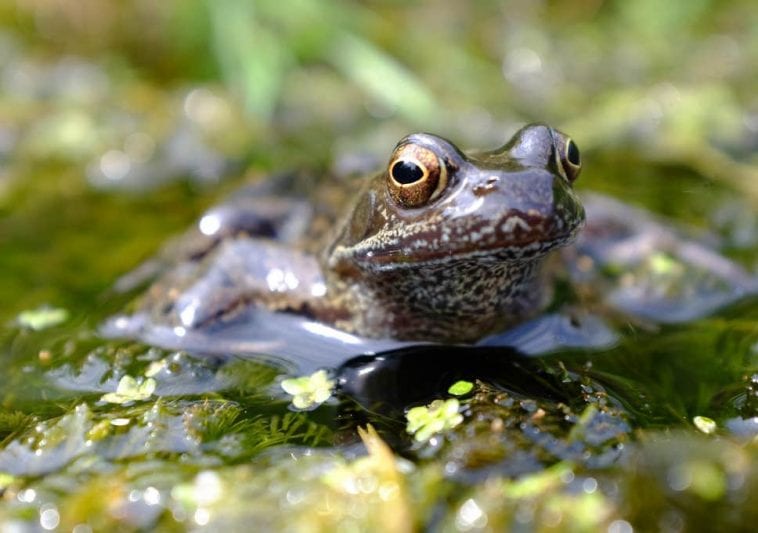There is an ongoing discussion regarding the impact of various chemicals on amphibians. Reviews in the past have established the thought of the possibility of chemicals being one of the major threats that are faced by amphibians.
It has also been observed that amphibians, as cold-blooded vertebrates, exhibit more reaction to amphibians compared with other vertebrate groups from aquatic and terrestrial environments. The risk for overexposure to these harmful chemicals continues to increase due to their permeable skin for ions and water.
Susceptibility to Chemicals
Amphibians, in general, are more susceptible to chemicals and pesticides than birds and other mammals. Chemicals may cause some harmful effects on animals, while also influencing the physiology and morphology of animals. Amphibians are sensitive to contamination and environmental changes since they spend most of their life in an aquatic environment.
Contamination caused by pollutants can cause alteration in the behavior of amphibians. The mortality rate among amphibians are very high, and they constantly face the risk of population reduction, especially in areas where there is an obvious excessive use of chemicals.
Impact on Population

On a global scale, it has been mentioned that the population of amphibians has declined by the day because of the excessive use of pesticides and chemicals that contaminate the natural environment while influencing the climatic condition of amphibians. According to the IUCN Red List in 2004, about 20 countries have already listed threatened species, with numbers increasing because of anthropogenic activities. Different environmental pollutants, including chemicals, play a huge role in the decline of the amphibian population. Chemical exposure increases their mortality rate even further.
Chemical Classifications
The following are some of the chemicals that have an adverse impact on amphibians:
· Carbamates
Carbamate insecticides come from the carbamic acid. The acute oral toxicity of carbamates has varying degrees, ranging from moderate to low toxicity to especially high toxicity. The toxicity mechanism of carbamates is similar to organophosphorus insecticides in the way that they also inhibit AChE. The symptoms of Carbamate’s impact on amphibians include diarrhea, urination, muscle fasciculation, salivation, and CNS effects.
· Organophospates
Organophosphorus compounds were formed back in the 1940s. Its chemical composition is consists of a phosphorus atom and a double bond of oxygen or sulfur, along with three other single bonds, plus two alkoxy groups and a leaving group. In general, these insecticides have phosphorus bound to sulfur. It acts on the acetylcholinesterase which affects the enzymes of amphibians.
Organophosphorus can also hydrolize acetylcholinesterase AChE. As the latter is the main neurotransmitter, it may result in some destructive effects on both the peripheral and central nervous systems of the amphibians.
· Organochlorine Compounds
Organochlorine is composed of carbon, hydrogen, and chlorine. They can also be identified as chlorinated hydrocarbons, chlorinated synthetics or chlorinated insecticides. Organochlorine is divided further into four major groups, including the dichlorodiphenyltrichloroethane (DDT), cyclodienes (endrin, aldrin, heptachlor, chlordane, dieldrin, chlordecone and endosulfan), hexachlorocyclohexane (lindane), and the related compounds of hexachlorocyclohexane.
While the acute toxicity of organochlorine compounds is temperate, chronic exposure to this chemical may also be the reason for the damage in the health of amphibians, especially in the liver, as well as the reproductive system of the organism.
· Pyrethroids
Pyrethrin is a natural insecticide that comes from Tanacetum Cinerariifolium and Chrysanthemum Cinerarifolium. It was first used back in the 1800s. Out of pyrethrin, several other drugs were created in order to control the pest population. These drugs have evolved into synthetic forms called pyrethroids.
Pyrethroids are stable chemically compared to pyrethrin. The latter, together with pyrethroid aerosols, are used often as automated insect sprays in many public areas. Pyrethroid pesticides present high toxicity to different types of insects, with low toxicity to amphibians. Pyrethroid can be easily degradable, which is why there is a wide range of use, though it may have an adverse effect on the central nervous system.
Toxicity Based on Exposure

There are generally two types of toxicity among amphibians:
· Chronic Toxicity
Chronic toxicity is caused by the long-term exposure of amphibians to a toxic material. The harmful effect is often caused by small but repeated doses for a period of time. Long-term exposure of chemicals may cause toxicity to a fetus, birth defects, formation of benign or malignant tumors, blood syndromes, genetic changes, nerve infections, an endocrine disorder, and other effects on reproduction. Chronic toxicity of a chemical is often more dangerous when compared to acute toxicity, as determined by laboratory experiments.
· Acute Toxicity
Acute toxicity is short term toxicity, which is often caused by a single exposure of chemicals. Among the more serious effects of single exposure is seen in the inhalation (lungs), dermal (skin), eyes, and oral (mouth). It is also inspected by inhalation toxicity, dermal toxicity, as well as oral toxicity. After the test, it measured LD50, with 50 as the Lethal Dose, which is the total concentration amount of toxicant which can easily kill half of the animals in the test population.
As determined by these two types of toxicity, chronic toxicity is the more serious type between the two, especially with aquatic amphibians since they stay in an aquatic medium, and repeatedly absorb pesticide by skin and mouth, which is lethal for these animals. Chemicals are very dangerous for reproduction and growth, even causing mutation among developing tadpoles. The study is further done in order to investigate behavioral or physiological changes and determine the influence of chemicals on pesticides.
Toxicity Impacts of Chemicals
· Oral or subcutaneous exposure
At times, amphibians ingest pesticides and chemicals orally through the food they eat. This can prove to be lethal for the development and growth of amphibians. Malathion and DDT, when exposed orally, may further lead to some immunosuppressive effect. The metabolism of DDT may also result in a decrease in the CYP26 gene as well as protein expression. It may also have an impact on the reproductive capability of amphibians, as well as their decrease in growth.
· Dermal exposure
Amphibians are easily exposed to chemicals when they are moving across agricultural fields while foraging for food and shelter. The skin of amphibians is highly penetrative, functioning as their water uptake and respiration mechanism.
Amphibians uptake water from their skin’s pelvic area. The pesticides absorb through the skin of some water molecules. These chemicals may also move to a venous circulation through the lymph channels. Thus, chemicals also move through the skin of the amphibians, causing some serious consequences which may further lead to several diseases, such as brain diseases and tumors.
Other vertebrates also feature a protective barrier for skin penetration. Chemicals inhibit the production of cholinesterase, which translates to the accumulation of acetylcholine in the postsynaptic membrane which causes Parkinson’s disease. This may result in death among amphibians.
Impact on Life Stages
It has been suggested that amphibians have the capacity to taste water using its skin. They can even check the appropriateness of water before doing so. It may prevent the contamination of pesticides. A high dose of chemicals causes an increase in mortality rate which is equivalent to 50% mortality among juvenile amphibians. Some chemicals are too strong that they delay the metamorphological stages, thus delaying in larval development, which then reduces the growth rate of the amphibian. Thus we are experiencing a decline in their population.



